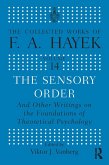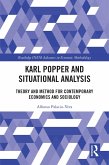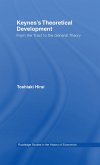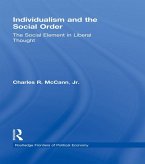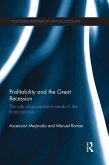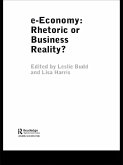F. A Hayek
The Sensory Order and Other Writings on the Foundations of Theoretical Psychology (eBook, PDF)
Redaktion: Vanberg, Viktor J.
45,95 €
45,95 €
inkl. MwSt.
Sofort per Download lieferbar

23 °P sammeln
45,95 €
Als Download kaufen

45,95 €
inkl. MwSt.
Sofort per Download lieferbar

23 °P sammeln
Jetzt verschenken
Alle Infos zum eBook verschenken
45,95 €
inkl. MwSt.
Sofort per Download lieferbar
Alle Infos zum eBook verschenken

23 °P sammeln
F. A Hayek
The Sensory Order and Other Writings on the Foundations of Theoretical Psychology (eBook, PDF)
Redaktion: Vanberg, Viktor J.
- Format: PDF
- Merkliste
- Auf die Merkliste
- Bewerten Bewerten
- Teilen
- Produkt teilen
- Produkterinnerung
- Produkterinnerung

Bitte loggen Sie sich zunächst in Ihr Kundenkonto ein oder registrieren Sie sich bei
bücher.de, um das eBook-Abo tolino select nutzen zu können.
Hier können Sie sich einloggen
Hier können Sie sich einloggen
Sie sind bereits eingeloggt. Klicken Sie auf 2. tolino select Abo, um fortzufahren.

Bitte loggen Sie sich zunächst in Ihr Kundenkonto ein oder registrieren Sie sich bei bücher.de, um das eBook-Abo tolino select nutzen zu können.
The Sensory Order , first published in 1952, sets forth F. A. Hayek's classic theory of mind in which he describes the mental mechanism that classifies perceptions that cannot be accounted for by physical laws. Hayek's substantial contribution to theoretical psychology has been addressed in the work of Thomas Szasz, Gerald Edelman, and Joaquin Fuster.
- Geräte: PC
- mit Kopierschutz
- eBook Hilfe
- Größe: 2.69MB
Andere Kunden interessierten sich auch für
![The Sensory Order and Other Writings on the Foundations of Theoretical Psychology (eBook, ePUB) The Sensory Order and Other Writings on the Foundations of Theoretical Psychology (eBook, ePUB)]() F. A HayekThe Sensory Order and Other Writings on the Foundations of Theoretical Psychology (eBook, ePUB)45,95 €
F. A HayekThe Sensory Order and Other Writings on the Foundations of Theoretical Psychology (eBook, ePUB)45,95 €![Karl Popper and Situational Analysis (eBook, PDF) Karl Popper and Situational Analysis (eBook, PDF)]() Alfonso Palacio-VeraKarl Popper and Situational Analysis (eBook, PDF)42,95 €
Alfonso Palacio-VeraKarl Popper and Situational Analysis (eBook, PDF)42,95 €![Keynes's Theoretical Development (eBook, PDF) Keynes's Theoretical Development (eBook, PDF)]() Toshiaki HiraiKeynes's Theoretical Development (eBook, PDF)14,95 €
Toshiaki HiraiKeynes's Theoretical Development (eBook, PDF)14,95 €![Individualism and the Social Order (eBook, PDF) Individualism and the Social Order (eBook, PDF)]() Charles McCannIndividualism and the Social Order (eBook, PDF)48,95 €
Charles McCannIndividualism and the Social Order (eBook, PDF)48,95 €![Profitability and the Great Recession (eBook, PDF) Profitability and the Great Recession (eBook, PDF)]() Ascension MejoradoProfitability and the Great Recession (eBook, PDF)37,95 €
Ascension MejoradoProfitability and the Great Recession (eBook, PDF)37,95 €![e-Economy (eBook, PDF) e-Economy (eBook, PDF)]() Leslie Budde-Economy (eBook, PDF)31,95 €
Leslie Budde-Economy (eBook, PDF)31,95 €![The Political Economy of Immigration in The Netherlands (eBook, PDF) The Political Economy of Immigration in The Netherlands (eBook, PDF)]() Joop HartogThe Political Economy of Immigration in The Netherlands (eBook, PDF)42,95 €
Joop HartogThe Political Economy of Immigration in The Netherlands (eBook, PDF)42,95 €-
-
-
The Sensory Order, first published in 1952, sets forth F. A. Hayek's classic theory of mind in which he describes the mental mechanism that classifies perceptions that cannot be accounted for by physical laws. Hayek's substantial contribution to theoretical psychology has been addressed in the work of Thomas Szasz, Gerald Edelman, and Joaquin Fuster.
Dieser Download kann aus rechtlichen Gründen nur mit Rechnungsadresse in A, B, BG, CY, CZ, D, DK, EW, E, FIN, F, GR, HR, H, IRL, I, LT, L, LR, M, NL, PL, P, R, S, SLO, SK ausgeliefert werden.
Produktdetails
- Produktdetails
- Verlag: Taylor & Francis eBooks
- Seitenzahl: 414
- Erscheinungstermin: 28. Juli 2017
- Englisch
- ISBN-13: 9781317562283
- Artikelnr.: 48867496
- Verlag: Taylor & Francis eBooks
- Seitenzahl: 414
- Erscheinungstermin: 28. Juli 2017
- Englisch
- ISBN-13: 9781317562283
- Artikelnr.: 48867496
- Herstellerkennzeichnung Die Herstellerinformationen sind derzeit nicht verfügbar.
F. A. Hayek (1899-1992), recipient of the Medal of Freedom in 1991 and co-winner of the Nobel Memorial Prize in Economics in 1974, taught at the University of London, the University of Chicago, and the University of Freiburg.
Viktor J. Vanberg is Professor Emeritus of Freiburg University and a senior research fellow of the Walter Eucken Institut in Freiburg.
Viktor J. Vanberg is Professor Emeritus of Freiburg University and a senior research fellow of the Walter Eucken Institut in Freiburg.
Preface Introduction I. The Nature of the Problem 1. What is Mind? 2. The
Phenomenal and the Physical World 3. Stimulus, Impulse, and the Theory of
the Specific Energy of the Nerves 4. Differences in Quality are Differences
in the Effects 5. The Unitary Character of the Sensory Order 6. The Order
of Sensory Qualities not Confined to Conscious Experience 7. The Denial or
Disregard of Our Problem by Behaviorism 8. The 'Absolute' Qualities of
Sensations a Phantom-Problem II. An Outline of the Theory 1. The Principle
of the Explanation 2. The Sensory Order in its Static and in its Dynamic
Aspects 3. The Principle of Classification 4. Multiple Classification 5.
The Central Thesis III. The Nervous System as an Instrument of
Classification 1. An Inventory of the Physiological Data 2. Simplifying
Assumptions on which the Operation of the Principle will be Discussed 3.
Elementary Forms of Classification 4. Complex Forms of Classification 5.
The Classification of the Relation Between Classes 6. The Universal
Character of the Process of Classification: Gestalt Phenomena and Abstract
Concepts IV. Sensation and Behaviour 1. Sensations and the Organism 2.
Evolution and the Hierarchal Order of the Nervous System 3. From Specific
Reflex to Generalized Evaluation 4. Proprioception of Low-Level Responses
5. Postures and Movements Connected with Perception 6. Patterns of Motor
Responses 7. Biogenic Needs and Drives 8. Emotions and the James-Lange
Theory V. The Structure of the Mental Order 1. Pre-Sensory Experience or
'Linkages' 2. The Gradual Formation of a 'Map' Reproducing Relations
Between Events in the Environment 3. The 'Map' and the 'Model' 4.
Associative Processes 5. Mechanical and Purposive Behaviour 6. The
Model-Object Relationship VI. Consciousness and Conceptual Thought 1.
Conscious and Unconscious Mental Processes 2. Criteria of Consciousness 3.
The Common Space-Time Framework 4. Attention 5. The Functions of
Consciousness 6. 'Concrete' and 'Abstract' 7. Conceptual Thought VII.
Confirmations and Verification of the Theory 1. Observed Facts for which
the Theory Accounts 2. Older Theories Comprised as Special Cases 3. New
Experiments Suggested 4. Possibilities of Experimental Refutation VIII.
Philosophical Consequences 1. Pre-Sensory Experience and Pure Empiricism 2.
Phenomenalism and the Inconstancy of Sensory Qualities 3. Dualisms and
Materialism 4. The Nature of Explanation 5. Explanation of the Principle 6.
The Limits of Explanation 7. The Division of the Sciences and the 'Freedom
of the Will' Bibliography Index
Phenomenal and the Physical World 3. Stimulus, Impulse, and the Theory of
the Specific Energy of the Nerves 4. Differences in Quality are Differences
in the Effects 5. The Unitary Character of the Sensory Order 6. The Order
of Sensory Qualities not Confined to Conscious Experience 7. The Denial or
Disregard of Our Problem by Behaviorism 8. The 'Absolute' Qualities of
Sensations a Phantom-Problem II. An Outline of the Theory 1. The Principle
of the Explanation 2. The Sensory Order in its Static and in its Dynamic
Aspects 3. The Principle of Classification 4. Multiple Classification 5.
The Central Thesis III. The Nervous System as an Instrument of
Classification 1. An Inventory of the Physiological Data 2. Simplifying
Assumptions on which the Operation of the Principle will be Discussed 3.
Elementary Forms of Classification 4. Complex Forms of Classification 5.
The Classification of the Relation Between Classes 6. The Universal
Character of the Process of Classification: Gestalt Phenomena and Abstract
Concepts IV. Sensation and Behaviour 1. Sensations and the Organism 2.
Evolution and the Hierarchal Order of the Nervous System 3. From Specific
Reflex to Generalized Evaluation 4. Proprioception of Low-Level Responses
5. Postures and Movements Connected with Perception 6. Patterns of Motor
Responses 7. Biogenic Needs and Drives 8. Emotions and the James-Lange
Theory V. The Structure of the Mental Order 1. Pre-Sensory Experience or
'Linkages' 2. The Gradual Formation of a 'Map' Reproducing Relations
Between Events in the Environment 3. The 'Map' and the 'Model' 4.
Associative Processes 5. Mechanical and Purposive Behaviour 6. The
Model-Object Relationship VI. Consciousness and Conceptual Thought 1.
Conscious and Unconscious Mental Processes 2. Criteria of Consciousness 3.
The Common Space-Time Framework 4. Attention 5. The Functions of
Consciousness 6. 'Concrete' and 'Abstract' 7. Conceptual Thought VII.
Confirmations and Verification of the Theory 1. Observed Facts for which
the Theory Accounts 2. Older Theories Comprised as Special Cases 3. New
Experiments Suggested 4. Possibilities of Experimental Refutation VIII.
Philosophical Consequences 1. Pre-Sensory Experience and Pure Empiricism 2.
Phenomenalism and the Inconstancy of Sensory Qualities 3. Dualisms and
Materialism 4. The Nature of Explanation 5. Explanation of the Principle 6.
The Limits of Explanation 7. The Division of the Sciences and the 'Freedom
of the Will' Bibliography Index
Preface Introduction I. The Nature of the Problem 1. What is Mind? 2. The
Phenomenal and the Physical World 3. Stimulus, Impulse, and the Theory of
the Specific Energy of the Nerves 4. Differences in Quality are Differences
in the Effects 5. The Unitary Character of the Sensory Order 6. The Order
of Sensory Qualities not Confined to Conscious Experience 7. The Denial or
Disregard of Our Problem by Behaviorism 8. The 'Absolute' Qualities of
Sensations a Phantom-Problem II. An Outline of the Theory 1. The Principle
of the Explanation 2. The Sensory Order in its Static and in its Dynamic
Aspects 3. The Principle of Classification 4. Multiple Classification 5.
The Central Thesis III. The Nervous System as an Instrument of
Classification 1. An Inventory of the Physiological Data 2. Simplifying
Assumptions on which the Operation of the Principle will be Discussed 3.
Elementary Forms of Classification 4. Complex Forms of Classification 5.
The Classification of the Relation Between Classes 6. The Universal
Character of the Process of Classification: Gestalt Phenomena and Abstract
Concepts IV. Sensation and Behaviour 1. Sensations and the Organism 2.
Evolution and the Hierarchal Order of the Nervous System 3. From Specific
Reflex to Generalized Evaluation 4. Proprioception of Low-Level Responses
5. Postures and Movements Connected with Perception 6. Patterns of Motor
Responses 7. Biogenic Needs and Drives 8. Emotions and the James-Lange
Theory V. The Structure of the Mental Order 1. Pre-Sensory Experience or
'Linkages' 2. The Gradual Formation of a 'Map' Reproducing Relations
Between Events in the Environment 3. The 'Map' and the 'Model' 4.
Associative Processes 5. Mechanical and Purposive Behaviour 6. The
Model-Object Relationship VI. Consciousness and Conceptual Thought 1.
Conscious and Unconscious Mental Processes 2. Criteria of Consciousness 3.
The Common Space-Time Framework 4. Attention 5. The Functions of
Consciousness 6. 'Concrete' and 'Abstract' 7. Conceptual Thought VII.
Confirmations and Verification of the Theory 1. Observed Facts for which
the Theory Accounts 2. Older Theories Comprised as Special Cases 3. New
Experiments Suggested 4. Possibilities of Experimental Refutation VIII.
Philosophical Consequences 1. Pre-Sensory Experience and Pure Empiricism 2.
Phenomenalism and the Inconstancy of Sensory Qualities 3. Dualisms and
Materialism 4. The Nature of Explanation 5. Explanation of the Principle 6.
The Limits of Explanation 7. The Division of the Sciences and the 'Freedom
of the Will' Bibliography Index
Phenomenal and the Physical World 3. Stimulus, Impulse, and the Theory of
the Specific Energy of the Nerves 4. Differences in Quality are Differences
in the Effects 5. The Unitary Character of the Sensory Order 6. The Order
of Sensory Qualities not Confined to Conscious Experience 7. The Denial or
Disregard of Our Problem by Behaviorism 8. The 'Absolute' Qualities of
Sensations a Phantom-Problem II. An Outline of the Theory 1. The Principle
of the Explanation 2. The Sensory Order in its Static and in its Dynamic
Aspects 3. The Principle of Classification 4. Multiple Classification 5.
The Central Thesis III. The Nervous System as an Instrument of
Classification 1. An Inventory of the Physiological Data 2. Simplifying
Assumptions on which the Operation of the Principle will be Discussed 3.
Elementary Forms of Classification 4. Complex Forms of Classification 5.
The Classification of the Relation Between Classes 6. The Universal
Character of the Process of Classification: Gestalt Phenomena and Abstract
Concepts IV. Sensation and Behaviour 1. Sensations and the Organism 2.
Evolution and the Hierarchal Order of the Nervous System 3. From Specific
Reflex to Generalized Evaluation 4. Proprioception of Low-Level Responses
5. Postures and Movements Connected with Perception 6. Patterns of Motor
Responses 7. Biogenic Needs and Drives 8. Emotions and the James-Lange
Theory V. The Structure of the Mental Order 1. Pre-Sensory Experience or
'Linkages' 2. The Gradual Formation of a 'Map' Reproducing Relations
Between Events in the Environment 3. The 'Map' and the 'Model' 4.
Associative Processes 5. Mechanical and Purposive Behaviour 6. The
Model-Object Relationship VI. Consciousness and Conceptual Thought 1.
Conscious and Unconscious Mental Processes 2. Criteria of Consciousness 3.
The Common Space-Time Framework 4. Attention 5. The Functions of
Consciousness 6. 'Concrete' and 'Abstract' 7. Conceptual Thought VII.
Confirmations and Verification of the Theory 1. Observed Facts for which
the Theory Accounts 2. Older Theories Comprised as Special Cases 3. New
Experiments Suggested 4. Possibilities of Experimental Refutation VIII.
Philosophical Consequences 1. Pre-Sensory Experience and Pure Empiricism 2.
Phenomenalism and the Inconstancy of Sensory Qualities 3. Dualisms and
Materialism 4. The Nature of Explanation 5. Explanation of the Principle 6.
The Limits of Explanation 7. The Division of the Sciences and the 'Freedom
of the Will' Bibliography Index

